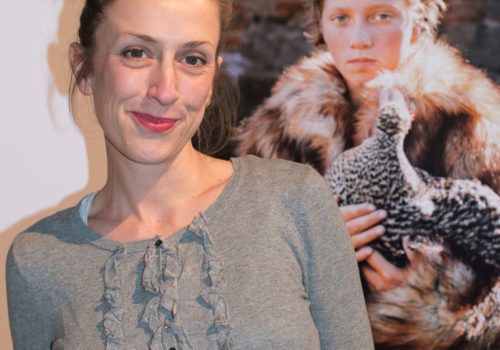Audrey Turpin is the General Coordinator of the Circulation(s) festival, and co-founding member Fetart Association. We spoke with Audrey about the opening of the 4th edition of the festival, which recently changed venues from the Parc de Bagatelle to Le Centquatre, and the economic side of an event working for young European photography.
Fetart is kicking off its fourth edition of the Circulation(s) festival. How do you think the festival has evolved over the years?
The festival follows the evolution of young artists. We are a mirror of young European photography. Everything is allowed, from the most challenging subjects to the most trivial. We’ve gotten the hang of things by now, but we’re still able to see things with fresh eyes.
One of the major changes this year is the festival’s move from Bagatelle to Centquatre. What do you hope this new venue will offer?
We are thrilled to have been invited to exhibit at the Centquatre. It suits us to be in Eastern Paris, which is our neighborhood, and above all to be involved in the programming of this space devoted to “popular culture” in the best sense of the term. The Centquatre is full of energy, just like us! It’s easy to reach with public transportation, it’s open to everyone, and an enormous amount of young people will be given access photography.
Can you tell us about the 2014 edition? What were you looking for in the work you selected?
Like every year, we made a call for submissions and received over 1,000 portfolios. Between the jury selection, the “carte blanche” given to festival godfather Xavier Canonne, and the invited schools and galleries, a total of 44 photographers will participate in the exhibitions, projections and installations at Centquatre. Whether their work explores the fictional world or private lives, whether it tells a story or a joke, their visions intertwine to tell us about our world with all its wounds and absurdities. Through Todd Antony’s spirited pom-pom girls, the transformed objects of the Danish collective Put Put, life in Afghanistan shot by Sandra Calligaro, or Virginie Plauchut’s approach to the sensitive subject of incest, we want to showcase the eclecticism and diversity of young European photography.
This year, you managed to successfully finance your catalogue through a crowdfunding platform. Does that mean that even after three years of existence, it’s still difficult to finance a photo event in Paris?
Unfortunately, yes. We’re driven by our energy and our volunteers, but it hurts not to have a permanent sponsor. We lost our three major private partners this year and we lack the support of European ministries. The situation is fragile and our budget is laughable compared to other photo events in France. Our goal is to find the money to hire two permanent employees who will guarantee that the festival continues. The arrival of 104 is a wonderful opportunity for us, but it also means new costs, especially when it comes to setting up the exhibition spaces.
Who are your main financial partners?
The Ile de France and the City of Paris have supported us since the beginning. We receive no other public subsidies. As for private partners, we lost our three biggest ones this year. Fortunately, Leica offered their support and we hope they’ll remain with us for many years.
Europe is at the heart of this festival. Are you able to cross borders and develop a European network among its 28 countries? Or is it still difficult?
Developing a European network takes a long time, but it isn’t difficult. We’ve been working on it since the beginning of the festival, and we’ve noticed a real desire in Europe to share and exchange. Our goal is to build bridges with European schools, galleries, festivals and institutions dedicated to the image. Every year we invite European festivals to become partners, and today there are several: Lódz Fotofestiwal (Poland), Encontros da Imagem de Braga (Portugal), Fotografia Europea de Reggio Emilia (Italy), In Focus (Vilnius, Lithuania), Biennale internationale de la Photographie et des Arts visuels de Liège (Belgium), Belfast Foto Festival (Ireland), and the Format Festival (United Kingdom). These festivals serve on the jury and help spread the word about call for submissions in their countries. They also host projection featuring work from the latest edition of Circulation(s). Every year we invite a school and a gallery to send us two artists. This year, it was the Belfast School of Art, University of Ulster (Ireland) and the Galerija Fotografija in Ljubljana (Slovenia). Finally, we try, as much as our finances allow, to visit other European festivals. Nothing can take the place of a face-to-face meeting.
What are the unmissable events at this year’s festival?
The opening, of course, tomorrow from 15:00 to 20:00! The projection-debate on Saturday, February 22nd at 16:00 with the Maison du Geste et de l’Image. The “traditional” portfolio reviews on Saturday, March 8th and Sunday, March 9th from 11:00 to 19:00. The Fetart Academy on Saturday, March 15, which aims introduce photographers to the professional photo world. The projection and presentation of The Eyes magazine. And, of course, thanks to the RATP, the Circulation(s) exhibitions in sixteen Paris metro stations.
















